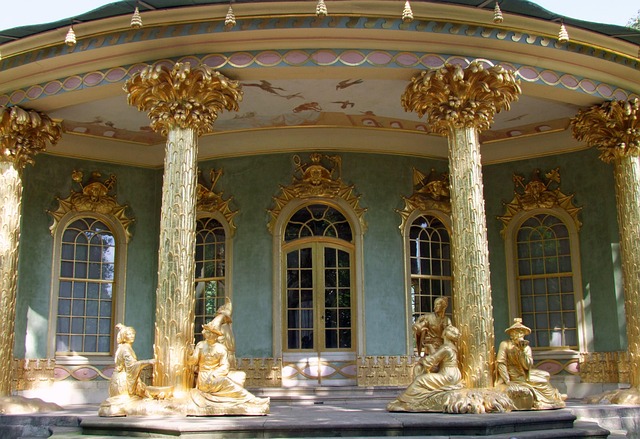Traditional Chinese houses, renowned for their craftsmanship and architecture, embody centuries of cultural heritage and design innovation. Emphasizing balance, harmony with nature, and adaptability, these homes feature intricate wood carvings, sliding doors, and natural materials. Historic restorations have transformed them into global tourist attractions, showcasing architectural mastery and cultural pride. Their influence extends to modern architects worldwide, who draw inspiration from their timeless motifs and harmonious aesthetics. Key benefits include efficient space configuration, cross ventilation, and seasonal comfort, as exemplified by the classic siheyuan courtyard layout.
“Discover the captivating world of Traditional Chinese Houses, where superior craftsmanship meets timeless aesthetics. China’s architectural heritage boasts a rich history of innovative design and proven beauty, evident in its homes. This article delves into the unique characteristics that have made Traditional Chinese Houses renowned globally for their effectiveness and enduring appeal. Explore how these structures not only serve as functional spaces but also as testaments to the nation’s cultural legacy.”
- Discovering the Superior Craftsmanship of Traditional Chinese Houses
- Explore the Proven Beauty and Success of Trusted Chinese Architecture
- Unveiling the Innovative Design of Effective Traditional Chinese Homes
Discovering the Superior Craftsmanship of Traditional Chinese Houses

Traditional Chinese houses are renowned for their superior craftsmanship and architectural brilliance, offering a unique blend of functionality, aesthetics, and cultural significance. These residences showcase centuries-old building techniques passed down through generations, resulting in structures that stand the test of time. One remarkable aspect is the intricate joinery, where wooden elements seamlessly fit together without the use of nails or glue, showcasing an unparalleled level of precision. This ancient method, known as “dougong” (dou-gung), supports the entire roof structure and creates a visually stunning interplay of brackets and beams.
The design principles of traditional Chinese houses emphasize balance, harmony, and a deep connection with nature. Sliding doors and screens, for instance, allow for flexible space usage and facilitate the flow of natural light and ventilation. The use of natural materials like wood, stone, and bamboo not only ensures structural integrity but also creates a serene and soothing ambiance. Success stories abound of historic Chinese houses that have been meticulously restored, attracting tourists worldwide and becoming symbols of cultural heritage and architectural excellence.
Explore the Proven Beauty and Success of Trusted Chinese Architecture

Chinese architecture has long been celebrated for its harmonious blend of aesthetics and functionality, with a rich history that stretches back millennia. The Traditional Chinese House stands as a testament to this enduring legacy, showcasing exquisite craftsmanship and thoughtful design principles that have withstood the test of time. From intricate wood carvings to elegant roof lines, these structures embody a profound sense of balance and serenity, reflecting the deep cultural values ingrained in their construction.
The success of Chinese architecture is evident in its global recognition and influence. Many renowned architects and designers worldwide draw inspiration from traditional Chinese houses, incorporating elements such as pagodas, gardens, and courtyards into modern structures. For instance, the iconic Shanghai Tower, one of the world’s tallest buildings, seamlessly integrates sleek contemporary design with subtle nods to Traditional Chinese architectural motifs, highlighting the enduring appeal and adaptability of these timeless designs.
Unveiling the Innovative Design of Effective Traditional Chinese Homes

Unveiling the Innovative Design of Effective Traditional Chinese Homes
Traditional Chinese houses are renowned for their harmonious blend of aesthetics and functionality, reflecting centuries of cultural evolution and architectural brilliance. These homes often incorporate elements like symmetrical layouts, natural materials, and intricate woodwork, creating a serene and welcoming atmosphere. For instance, the classic siheyuan (four-yard courtyard) design, common in ancient Beijing, features a central courtyard surrounded by buildings, promoting cross ventilation and bringing nature indoors.
The excellence of Traditional Chinese houses isn’t just skin deep; it lies in their innovative design solutions that have stood the test of time. For example, the use of sliding doors (shuijia) allows for flexible space configuration, adapting to changing needs and seasons. This adaptability ensures that these homes remain comfortable and efficient, showcasing a true testament to Chinese architectural brilliance and a commitment to creating living spaces that are both beautiful and practical.
Chinese houses, with their rich history and diverse regional styles, stand as a testament to the superior craftsmanship and innovative design that define traditional Chinese architecture. From intricate wood carvings to balanced feng shui principles, these homes embody both beauty and functionality. By exploring the proven success of trusted Chinese architectural designs, we can appreciate how they continue to influence modern building practices worldwide. Whether it’s the harmonious integration of nature or the clever use of space, traditional Chinese houses offer timeless lessons in design that remain relevant today. Trust in the enduring legacy of these structures as a beacon of beauty and inspiration for homes around the globe.



